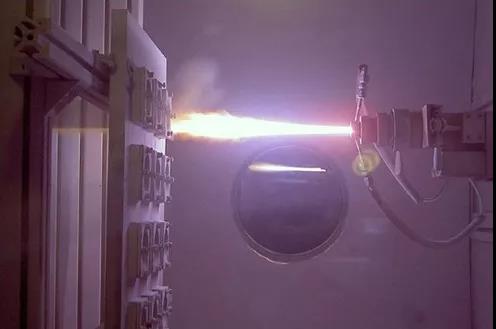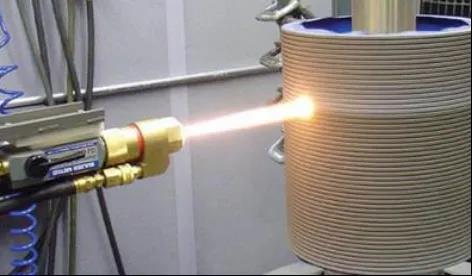In order to keep up with the development of the manufacturing industry, surface engineering technology came into being. This technology can achieve a substantial improvement in material performance with low investment, and has significant economic benefits. In recent years, the preparation of wear-resistant ceramic coatings on the surface of the substrate has become a hot spot for scholars at home and abroad.

Wear-resistant ceramic coating performance
Ceramic has the characteristics of high melting point, high hardness, high strength, high chemical stability, high insulation capacity, low thermal conductivity, low thermal expansion coefficient, etc., used as a coating can effectively improve the wear resistance, high heat resistance and corrosion resistance of the base material And resistance to high temperature oxidation and other properties. Ceramics have properties that are difficult to achieve with metal materials, so they are widely used in the preparation of various ceramic coatings. Wear-resistant ceramics combine the advantages of ceramics with the toughness of metal materials. Spraying on the surface of the material can make the material have the characteristics of metal's strength, toughness, workability, and ceramic's wear resistance, high temperature resistance, corrosion resistance and insulation. Such performance is of great significance for improving social and economic benefits and prolonging the service life of parts.
Wear-resistant ceramic classification
Wear-resistant ceramics are a typical structural ceramics, mainly including oxide ceramics, carbide ceramics and nitride ceramics.
Oxide ceramics are ceramic materials that have been developed and applied relatively early. They are ionic crystals. Their anions and cations are combined by strong ionic bonds, so they have the characteristics of high temperature resistance, high strength, and oxidation resistance. Generally, the melting point is higher than 1730. ℃ simple oxide ceramics or composite oxide ceramics, such as aluminum oxide, magnesium oxide, titanium oxide, mullite, spinel, etc. Some oxide ceramics, such as zirconia and alumina, are widely used in human joints, bone screws, ear bones and other fields due to their chemical stability and wear resistance.
Nitride ceramics started late and have only developed rapidly since the 1970s. Almost all of them are artificially synthesized. In addition to high strength and high hardness, they also have excellent electrical and thermal properties. After years of research, the brittleness and reliability of nitride ceramics have been significantly improved. After decades of development, nitride ceramics such as silicon nitride, aluminum nitride, and boron nitride have been widely used in aerospace, machinery, metallurgy and other fields as high-strength mechanical parts, corrosion-resistant parts, and wear-resistant parts.
Carbide ceramics are widely used in silicon carbide (SiC), boron carbide (B4C), titanium carbide (TiC), tungsten carbide (WC), etc. For example, SiC is used in engine turbocharger rotors, sliding bearings, and high temperature Exchanger, etc.; Boron carbide is used for bullet-proof armor, etc.; Titanium carbide is used for preparing knives. The main advantages of carbide ceramics are high melting point and high hardness. For example, the hardness of B4C is second only to diamond and CBN.
Ceramic coating preparation method
1.Vapor Deposition Method
Vapor deposition methods are divided into physical vapor deposition (PVD) and chemical vapor deposition (CVD). PVD technology emerged in the late 1970s. It uses physical methods to vaporize materials into ions, atoms or molecules under vacuum conditions to form a protective film on the surface of the substrate. The process includes evaporation, transmission, reaction, and deposition. . PVD film has strong adhesion, wear resistance, corrosion resistance, and strong oxidation resistance. CVD is a technology that uses gaseous substances to form a solid film on the surface of a substrate through a chemical reaction. It is essentially a gaseous mass transfer process in the atomic category. It has the following characteristics: it can be carried out under normal pressure or vacuum conditions; it can be coated at low temperatures. ; The structure and purity of the coating can be controlled; the coating performance is good.
2.Sol-gel method
The sol-gel method (Sol-Gel) preparation ceramic coating technology is to use easily hydrolyzed metal alkoxide or inorganic salt to react with water in a certain solvent, and form a sol through hydrolysis and condensation polymerization, and then coat the sol on the surface of the metal substrate. After drying and heat treatment, a coating is formed. This method can be carried out at low temperature, and the prepared coating quality is high, but the process is complicated and time-consuming, and the film is easy to crack.
3.Self-propagating high-temperature synthesis
Self-propagating high temperature synthesis (SHS) is a small-scale reaction induced by external energy, and the high chemical reaction heat generated between the reactants is used to promote the continuous spontaneous chemical reaction of the reactants, and the target product is synthesized in a short time. A kind of new technology, has the advantages of low cost, low pollution, easy to manufacture, and its principle is shown in the figure below.

4.Thermal spray method
The thermal spraying method was first invented by Sehoop of Switzerland in 1910. It melts and atomizes the coating material at a high temperature to form a molten or semi-molten particle stream, which is sprayed on the surface of the metal substrate at a very high speed. The coating method. Thermal spraying has a wide range of applications, good coating effects, simple equipment and high efficiency. It is not only used to prepare ceramic coatings, but it is also very competitive in the field of parts repair.
5.High temperature sintering method
The high-temperature sintering method is to make the coating material into a slurry at room temperature, then uniformly coat it on the metal surface, and prepare the coating material by high-temperature sintering. This method has the characteristics of simple equipment and easy operation, and is one of the important methods for preparing ceramic coatings. In addition, this method can also repair damaged coatings, either by using high-temperature treatment to make it self-compensating, or by filling the slurry with appropriate high-temperature treatment.
6.Laser cladding
Laser cladding is to spray powder with special properties (such as wear resistance, corrosion resistance, oxidation resistance, etc.) on the metal surface or feed the powder synchronously with the laser beam, and then make it melt, expand and quickly under the action of the laser beam. Solidification, a surface modification technology to form a metallurgical bonding layer without cracks and pores on the surface of the substrate. Laser cladding has many advantages: flexible application, low energy consumption, low heat input, small thermal deformation caused, no need for subsequent processing or small processing volume, and reduced pollution.Laser cladding ceramic coatings also have some shortcomings. In the laser cladding process, the cladding layer is rapidly heated, melted, and then rapidly cooled, which is non-equilibrium solidification, and the difference between the coating material and the base material is large, and there are many influencing factors in the laser processing process. As a result, the quality of the cladding layer is not easy to control, and as a result, certain defects such as pores, cracks, burnout, etc. often appear in the coating.
Concluding remarks
Wear-resistant ceramic coatings have obvious effects on improving the wear resistance and corrosion resistance of the substrate, and are very critical in the use of equipment parts. Its relative wear resistance is significantly better than that of conventional wear-resistant materials. It is widely used to extend the life of large-scale components working in severely worn environments and reduce the energy consumption of large-scale wear components. It is in line with the national sustainability of energy conservation, material conservation, and environmental protection. development strategy.



